One of my latest acquisitions, a Gerber Magnum from around 1965
5 1/2" x .100 heavy duty blade (M2 high speed tool steel)
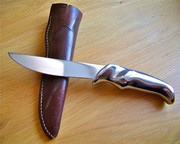
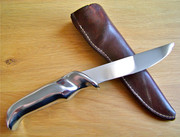
This is the knife that Gerber called Lamb Handled Hunter from the late 1950s until 1965, and then called Mg = Magnum Hunter until it was discontinued in 1969.
This handle shape, first used by Gerber on the Abercrombie & Fitch Hunter in September 1947, was patented by Thomas Lamb of New York City in December 1945 No. 2,390,544 and licensed to Gerber.
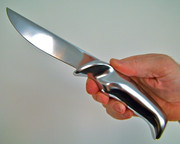
Gerber licensed Lamb's 1945 utility patent (most of his later patents were design patents) to make the Abercrombie & Fitch Hunter, and these were made from Sept 1947 to April 1953.
They have unplated aluminum handles, and are usually marked for A&F.
A modified version of this with plated handle was introduced in the late 1950s (dunno the exact date), called Lamb Handled Hunter.
Its name was changed to Big Hunter in 1959, and its name was changed again, to Magnum, in 1965.
(Source: Bernard Levine)
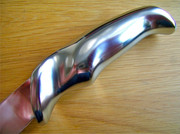
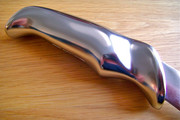
The first Magnum models were made with bright chrome handles and later coated with a “Steel Grip” finish (that was sprayed stainless steel) and then “Armorhide” coated (sprayed Teflon) and finally coated with black powder-coating (epoxy powder that is heated to bond it in place).
Some of the first knives had M-2 tool steel blades and later they were changed to 440C.
Both are great hunting knives and if they are in good condition they are becoming collectable.
The handles on all of these knives in die-cast aluminum that is cast onto the blade and then finished to shape and coated with one of the above processes.
This makes a virtually indestructible knife.
(Source: Doug Hutchens, Gerber production manager)
Like Charles and Ray Eames, Lamb noted the inadequacy of the crutches used by wounded and disabled veterans.
Initially focusing on the armrest, Lamb quickly noted that the hand bore the main burden, and began to experiment with ways to redistribute the pressure and make the crutches easier to handle.
After extensive study anatomical and medical textbooks he developed his Lamb Lim Rest crutch.
Designer Thomas Lamb in front of many examples of his work.
The Gerber Magnum can be seen on both pictures on the right wall.
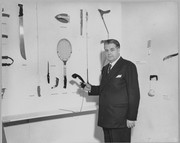
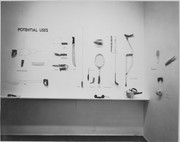
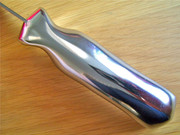

Becoming the "Handle Man"
Lamb applied the patents developed in designing the Lim Rest to cookware, cutlery, surgical tools, luggage, sports equipment, and industrial equipment.
His designs culminated in his unique "Wedge-Lock" and "Universal" handles, and were a major influence on the Universal Design movement.
By the late 1940s Thomas Lamb was known as the "Handle Man".
In 1948 his work was featured at the Museum of Modern Art during the period when the design establishment were focused on Bauhaus-inspired functionality.
This publicity led to contracts to produce a line of cutlery for Cutco and cookware for Wear-Ever.
Thomas Lamb died on February 2, 1988 at ninety-one years of age.
(Source: Wikipedia)
Gerber Legendary Outdoor Blades made from the steel that cuts other steel
" Imagine owning a blade as hard as a file, yet tough and springy !
Impossible in any cutlery steel - possible only in the kind of high alloy tool steel, which only Gerber is extravagant enough to use for knives.
Besides costing three times as much as any cutlery steel, it costs a lot more to make into a knife.
But it pays in the long run. It outlasts the user.
And all the time you own it you can be cutting with a sharper edge.
It's the knife you want on any outdoor adventure.
Complete with cowhide belt scabbard and unconditional guarantee."

5 1/2" x .100 heavy duty blade (M2 high speed tool steel)


This is the knife that Gerber called Lamb Handled Hunter from the late 1950s until 1965, and then called Mg = Magnum Hunter until it was discontinued in 1969.
This handle shape, first used by Gerber on the Abercrombie & Fitch Hunter in September 1947, was patented by Thomas Lamb of New York City in December 1945 No. 2,390,544 and licensed to Gerber.

Gerber licensed Lamb's 1945 utility patent (most of his later patents were design patents) to make the Abercrombie & Fitch Hunter, and these were made from Sept 1947 to April 1953.
They have unplated aluminum handles, and are usually marked for A&F.
A modified version of this with plated handle was introduced in the late 1950s (dunno the exact date), called Lamb Handled Hunter.
Its name was changed to Big Hunter in 1959, and its name was changed again, to Magnum, in 1965.
(Source: Bernard Levine)


The first Magnum models were made with bright chrome handles and later coated with a “Steel Grip” finish (that was sprayed stainless steel) and then “Armorhide” coated (sprayed Teflon) and finally coated with black powder-coating (epoxy powder that is heated to bond it in place).
Some of the first knives had M-2 tool steel blades and later they were changed to 440C.
Both are great hunting knives and if they are in good condition they are becoming collectable.
The handles on all of these knives in die-cast aluminum that is cast onto the blade and then finished to shape and coated with one of the above processes.
This makes a virtually indestructible knife.
(Source: Doug Hutchens, Gerber production manager)
Like Charles and Ray Eames, Lamb noted the inadequacy of the crutches used by wounded and disabled veterans.
Initially focusing on the armrest, Lamb quickly noted that the hand bore the main burden, and began to experiment with ways to redistribute the pressure and make the crutches easier to handle.
After extensive study anatomical and medical textbooks he developed his Lamb Lim Rest crutch.
Designer Thomas Lamb in front of many examples of his work.
The Gerber Magnum can be seen on both pictures on the right wall.




Becoming the "Handle Man"
Lamb applied the patents developed in designing the Lim Rest to cookware, cutlery, surgical tools, luggage, sports equipment, and industrial equipment.
His designs culminated in his unique "Wedge-Lock" and "Universal" handles, and were a major influence on the Universal Design movement.
By the late 1940s Thomas Lamb was known as the "Handle Man".
In 1948 his work was featured at the Museum of Modern Art during the period when the design establishment were focused on Bauhaus-inspired functionality.
This publicity led to contracts to produce a line of cutlery for Cutco and cookware for Wear-Ever.
Thomas Lamb died on February 2, 1988 at ninety-one years of age.
(Source: Wikipedia)
Gerber Legendary Outdoor Blades made from the steel that cuts other steel
" Imagine owning a blade as hard as a file, yet tough and springy !
Impossible in any cutlery steel - possible only in the kind of high alloy tool steel, which only Gerber is extravagant enough to use for knives.
Besides costing three times as much as any cutlery steel, it costs a lot more to make into a knife.
But it pays in the long run. It outlasts the user.
And all the time you own it you can be cutting with a sharper edge.
It's the knife you want on any outdoor adventure.
Complete with cowhide belt scabbard and unconditional guarantee."

Last edited:
